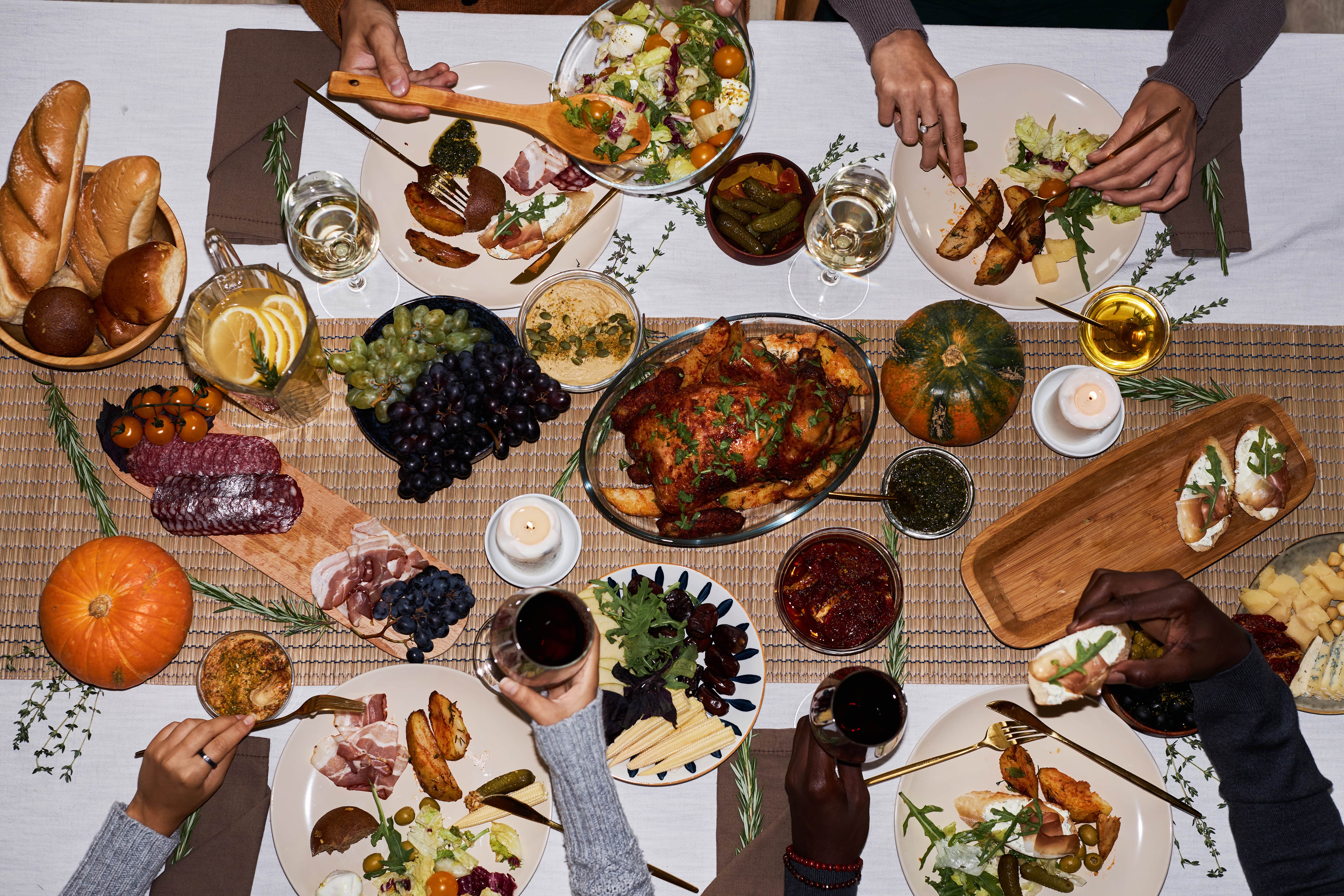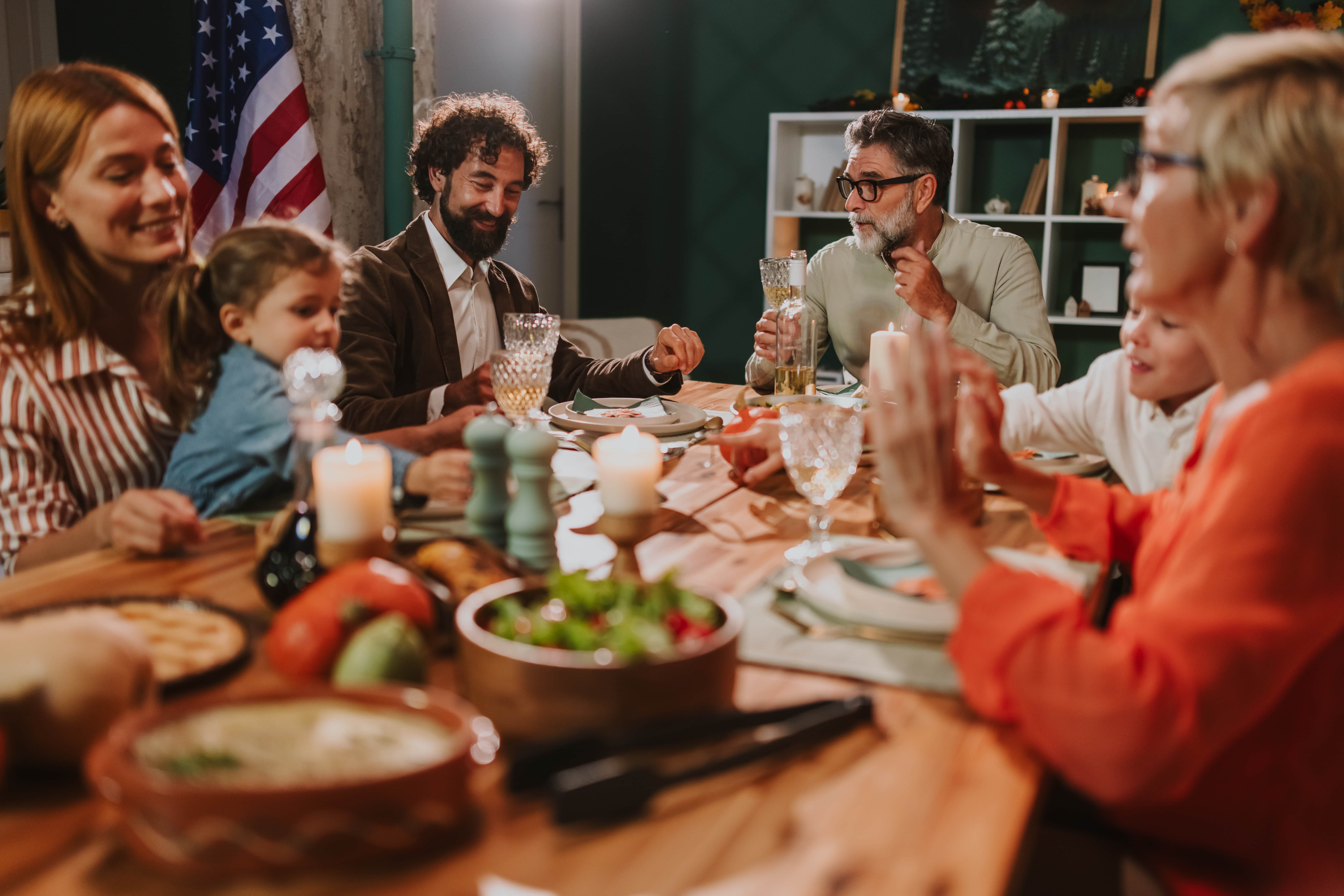Key Takeaways
- The holidays often come with “food pushers”: well-meaning friends and family whose offers of food in social settings can make mindful eating feel nearly impossible.
- With awareness, self-trust, and tools like Signos to support your health goals, you can enjoy every celebration without guilt or pressure.
- Learning to say “no” gracefully is about confidence, not deprivation. Understanding your triggers, setting boundaries, and practicing kind but firm responses can help you stay on track.
that {{mid-cta}}
When you’re committed to a healthy lifestyle, the holidays can feel like playing mindful eating on hard mode. From grandparents insisting you need “just one more slice” of pie, to that co-worker determined to refill your wine glass at the office Christmas party: holiday food pressure can come from every direction, no matter how focused you are on your health goals.
Now, saying no to tempting ads on Instagram is one thing, but turning down friends, family, and loved ones? That’s where things get tricky. It can feel awkward or downright rude, no matter your best intentions.
This guide will show you how to say no to food pushers while staying connected and enjoying the season. We’ll share the importance of setting boundaries and maintaining your healthy holiday mindset.
Why Food Pressure Happens

If a loved one still insists you try the pumpkin pie after one “no thank you” and two attempts to change the subject, it’s easy to label them a saboteur, looking to derail your healthy habits.
But before you place them on the naughty list, remember that food pushing often comes from a place of love. Sharing food is one of the oldest ways we show care plus connection, and no season celebrates this more than the holidays.
When a loved one insists you try what they made, it’s usually their way of saying they want you to join in the celebration, not to sabotage your progress. And because you understand that, saying “no” can feel even harder, especially when you know how much care went into the meal.
There’s also the social side of things. When everyone else is shuffling for seconds and thirds, it can feel awkward to hold your ground. You don’t want to seem rude or ungrateful, or like you’re too good for the group meal. That’s usually where subtle peer pressure comes in. That desire not to disappoint can nudge you to say yes when you’d rather call it a night.
Understanding these dynamics can help you respond with more compassion for yourself and the person offering, while still protecting the healthy habits and hard work you’ve put in.
The Hidden Impact of Giving In

Even with a solid plan to say “no thank you” when offered food, three little words can weaken the strongest defenses: “just one bite.”
But a tiny forkful here, and a slice there can be the small indulgence that throws off your glucose stability, especially because it’s rarely ever just one bite. If you’re managing your blood sugar or practicing mindful eating, even small nibbles can throw things off, especially at family gatherings or office parties stacked with sugary desserts and refined carbs.
When you eat something high in simple carbs, your body quickly converts it to glucose, flooding your bloodstream with sugar. Your pancreas releases insulin to move that glucose into your cells for energy, but the sharper the spike, the harder your body has to work to bring levels back down. When blood sugar drops just as fast, you’re left feeling tired, irritable, and craving more food, restarting the cycle all over again.
That’s why one extra bite after a carb-heavy meal can leave you feeling sluggish or reaching for more sweets a few hours later. Knowing your limits and gently turning down family members, friends, and other loved ones who try to push food on you can be an important act of self-care.
Scripts for Saying “No, Thanks” Gracefully

Sometimes the hardest part of the holidays isn’t the long road trips or crowded airports, it’s figuring out how to turn down food pushers without feeling like you’re starting a war. Thankfully, saying no can be done gently, and all it requires is a good mix of confidence and kindness.
Practice saying “no”
Before the holiday season, practice and build some resistance by routinely turning down offers to have more food when you’re not hungry or have had enough. Try this out with free samples, dessert, or baked goods in the break room. The more you practice, the more natural it feels when face-to-face with food pushing.
Get your responses ready
When it comes to food pushers, being firm yet kind is key, and having a few go-to responses in your back pocket makes it much easier. Examples include:
- “That looks incredible, but I’m full right now.”
- “You’re such a great cook! I’ll grab a plate when I’m hungry.”
- “I already had some, and it was so delicious.”
- Or very simply, “No, thank you.”
Deflect with humor or gratitude
To keep things friendly, you can also say no in a light-hearted manner. Here’s how:
- “Oh no, I’ll have to be wheeled out if I have another bite.”
- “No thanks, I’ll let my eyes do the feasting this time.”
- “My full belly wins this round, but I’ll try some of this (food) later.”
Share your journey
If your doctor, dietitian, or healthcare provider has recommended lifestyle changes, mentioning that you’re managing a health condition can help others better respect your boundaries.
Handle persistent pushers gracefully
If someone insists or makes you feel guilty about turning down their offer of food, acknowledge their effort while staying firm.
- “That’s so kind of you! Let me take some home instead.”
- “It looks amazing, but I promised myself I’d stay mindful this season.”
- “Thank you so much, but I’m sticking to what my doctor and I discussed.”
Building Confidence and Boundaries

Setting boundaries around food starts with adjusting how you view your relationship with eating. When you shift your mindset from “I can’t have that” to “I’m choosing what supports me,” intuitive eating stops feeling like punishment and instead starts feeling like self-care.
Once that mindset is in place, feedback starts to feel like empowerment. Tracking how different foods, routines, or habits affect your energy or blood sugar gives you real proof of progress in your eating habits. When you can see the connection between your choices and feeling better, it’s easy to stand firm when a food pusher shows up.
Self-talk can also boost confidence. Instead of guilt or all-or-nothing thinking, practice calm, encouraging reminders like “I can enjoy the holidays without overdoing it” or “Saying no doesn’t make me rude, it makes me mindful.” The more you practice this approach, the more natural it becomes to guard your wellness without guilt.
How Signos Helps You Stay on Track

Think of Signos as your accountability partner during a season when food pressure is everywhere. Instead of relying solely on willpower, you have data-backed clarity guiding each decision.
With continuous glucose monitoring, Signos turns invisible metabolic reactions into visual feedback you can use in the moment. You’ll see in real time how your glucose responds to holiday treats, big meals, late-night snacking, or skipped movement, and those curves make it easier to say “no thanks” with confidence. When you see how certain foods spike you (and how long it takes to come back down), it becomes much easier to choose what’s actually worth it.
It also helps you stay one step ahead of holiday challenges:
- Weekly Insights & Personalized Alerts: Before a gathering, you can check your patterns to know which foods historically spike you the most. If you choose to indulge, you’ll get a gentle nudge when glucose is rising so you can take a quick walk or add protein to slow the rise.
- Smart Experiments: Run simple Signos experiments to build your “holiday playbook” ahead of time: things like comparing your response to a cookie before vs. after a walk, testing whether adding fiber reduces a spike, or swapping a traditional holiday treat for a higher-protein version. This lets you arrive at events already knowing what works for your body.
- Meal Pairing Guidance: By reviewing your own glucose patterns, you can identify which combinations keep you in the purple optimal zone. This makes it easier to decline certain foods because you’re choosing energy, clarity, and comfort over a guaranteed crash.
- Data-Driven Boundaries: When you know your glucose response, saying no doesn’t feel restrictive; it feels strategic. You’re not passing up foods because you “should;” you’re choosing what aligns with your metabolic goals.
Signos is also especially helpful because holiday glucose patterns are different. Across the Signos member base, glucose variability tends to rise significantly during the holiday season due to richer meals, more treats, and less structured routines. Seeing this in your own data allows you to stay intentional instead of getting swept up by the season’s momentum.
The Bottom Line
Food pushers may be lurking at many tables this holiday season, but they don’t have to push you off track. While you can’t control how often you’re offered another helping, you can use tools like Signos to choose balance over pressure. With a clear sense of what supports your health, you can enjoy every celebration without guilt, and with confidence that you’re still honoring your goals.
Learn More With Signos’ Expert Advice
As much as you’d love a break, your metabolism doesn’t clock out for the holidays. Understanding how this system operates during the festive season and year-round can feel like a tough nut to crack. Fortunately, Signos helps connect the dots between your daily habits and overall well-being, offering guidance on improving your health and expert insights on glucose levels through the Signos blog to help you keep your energy steady all year round.
Topics discussed in this article:
References
1. Sapra, A., & Bhandari, P. (2023, June 21). Diabetes. In StatPearls. StatPearls Publishing. https://www.ncbi.nlm.nih.gov/books/NBK551501/




.svg)










.svg)
.svg)
.svg)
.svg)
.svg)
.svg)
.svg)
